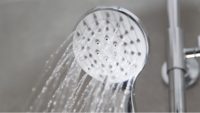The plumbing industry was somewhat surprised when the U.S. Department of Energy (DOE) finalized the definition of showerhead, body spray and safety shower showerhead into federal law. The final rule is available at: https://bit.ly/3qXl1wi.
The definition of showerhead reads, “Showerhead means any showerhead (including a handheld showerhead) other than a safety showerhead. DOE interprets the term “showerhead” to mean an accessory to a supply fitting for spraying water onto a bather, typically from an overhead position.”
The definition of body spray reads, “Body spray means a shower device for spraying water onto a bather from other than the overhead position. A body spray is not a showerhead.”
The definition of safety shower showerhead reads, “Safety shower showerhead means a showerhead designed to meet the requirements of ISEA Z358.1 (incorporated by reference, see §430.3).”
Most plumbing manufacturers thought when DOE proposed the rule, it was nice but had very little chance of being finalized. That is why it was so shocking when on Dec. 8, 2020, the final rule was signed into law. Virtually every water conservation group in the United States opposed the definitions when they were first proposed. DOE received thousands of comments in opposition to the new definitions — one of these comments had 10,184 signatures.
Water conservation worries
Many comments identified the definition of showerhead as a loophole to get around water conservation requirements. With each showerhead regulated for water conservation, there are no requirements stipulating how many showerheads can be used by a single bather. If a shower has two, three or more showerheads, the amount of water that can be used to take a shower can increase accordingly. Rather than showering with 2.5 gpm, a bather could use 5 gpm, 7.5 gpm, or even more water.
While this sounds devastating, the vast majority of showers have a single showerhead. Hence, there is water conservation. Of the showers having two showerheads, many have an overhead showerhead and a hand-held showerhead. While the diverter can operate either or both, often only one showerhead is used while showering. Again, there is water conservation.
In my own house, the master bathroom has a shower with two showerheads; one is an overhead rainfall showerhead, the other is a hand-held showerhead with multiple water spray settings. I like using the rainfall showerhead; my wife likes using the handheld showerhead. While the diverter will allow water to both showerheads simultaneously, that never occurs while showering. Being a big believer in water conservation, I find that 2 gpm is plenty of water for showering.
As Plumbing Manufacturers International (PMI) pointed out in its comment to DOE, WaterSense has done more for water conservation than the federal energy policy. PMI indicated that, from 2015 to 2020, the number of WaterSense showerheads increased from 3,500 models to 9,000 models. A WaterSense showerhead is limited to 2.0 gpm, as opposed to the Federal mandate of 2.5 gpm. PMI also pointed out that more than 45% of the new showerheads installed in residences use 2.0 gpm or less. All of this is occurring without any changes to the federal definition.
Perhaps the addition of the definition of body sprays has the biggest impact regarding water conservation. Body sprays were often considered the equivalent to a showerhead. Hence, all of the body sprays installed within a shower enclosure would be limited to a total of 2.5 gpm. With the definition added to federal law, a body spray becomes a fixture that is not regulated regarding flow rates. A body spray can have an unlimited flow of water.
The least controversial part of the DOE final rule is the definition of safety shower showerhead. It has long been understood that emergency fixtures are not a part of water conservation. Safety showers have a minimum flow rate of 20 gpm for 20 minutes. To assure that the term “safety shower showerhead” is not abused, the definition does reference ISEA Z358.1, which was added as a referenced standard.
In the long run, this change in federal law will have little impact on the plumbing design community. There has been a long understanding in the profession that the federal water conservation requirements apply to an individual showerhead, not a shower. Hence, multiple showerheads have been used and installed without any violation of federal law. At the same time, most engineers, contractors and building owners are switching to more water conserving showerheads.
Furthermore, since 2010, the preemption has been removed from the federal water conservation requirements. States are free to further regulate their water conservation requirements beyond what is listed by the federal government. California is a great example of a state that has lowered the water conservation requirements for a showerhead from 2.5 gpm (the federal mandate) to 1.8 gpm. Nothing in the new definitions will prevent California or other states from adding more restrictive water conservation requirements for plumbing fixtures.
The green codes are already attempting to define how many showerheads can be installed in a shower of a given size. It is anticipated that there will be further attempts to regulate how many showerheads are allowed for an individual shower.
The body spray definition will present a different challenge to the codes. Currently, the plumbing codes do not include a definition of body spray. Furthermore, there is no classification of maximum water use listed for body sprays. Changes may be forthcoming to the codes to regulate body sprays.
As a final note, I have to tip my hat to the plumbing fixture manufacturers. When showerhead water conservation measures were first added to the plumbing codes in the 1980s, all that occurred was the inclusion of a flow restrictor. Since that time, plumbing fixture manufacturers have developed many new showerheads with spray patterns that are great for showering with 2 gpm or less of water. I personally love my 2 gpm showerhead.
The changes enacted by DOE occurred at the end of the Trump administration. Former President Trump has been outspoken regarding his opposition to the federal water conservation requirements. It will be interesting to see if things change under the Biden administration. Environmental, water conservation and climate change issues seem to be more in the forefront of the Biden administration.
The views expressed here are strictly those of the author and do not necessarily represent PM Engineer or BNP Media.




